-

-
We are specialists for your holidays in La Palma. With personalized assistance on-site.
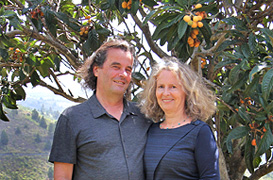
Ulrich & Evelyn Roth -
Our service numbers
Write e-mail+34 822 68 00 89
+49 7442 819 85 90
We're available from Monday to Friday from 10:00 a.m. to 6:00 p.m., and Saturdays from 10:00 a.m. to 1:00 p.m.
-
Accommodations
- with pool 90
- on the seaside 42
- with internet 205
-
Northwest >>
130
- Aguatavar 7
- Arecida 6
- El Castillo 1
- Garafía 4
- Las Tricias 7
- Puntagorda 42
- Tijarafe 22
- Tijarafe Costa 6
- Tijarafe El Jesús 12
- Tijarafe La Punta 21
- Tinizara 2
-
Aridane Valley >>
225
- Celta 7
- Charco Verde 3
- El Paso 23
- Hermosilla 1
- La Bombilla 2
- La Laguna 11
- Las Manchas 24
- Las Norias 11
- Los Llanos de Aridane 25
- Puerto de Naos 45
- San Nicolas 8
- Tacande 2
- Tajuya 9
- Tazacorte Costa 5
- Tazacorte Puerto 14
- Tazacorte Villa 23
- Todoque 12
-
South >>
31
- Fuencaliente 7
- Las Indias 4
- Lomo Oscuro 1
- Los Quemados 6
- Salemera 2
- Tigalate 2
- Villa de Mazo 9
- East >> 16
-
Northeast >>
5
- Barlovento 2
- Los Sauces 2
- Puntallana 1
The Cory's Shearwater
“pardela cenicienta”
"pardela cenicienta", "tapagao"
Cory's Shearwater
Calonectris diomedea
Unfortunately, in particular young animals of the exemplary Canary bird are threatened. The organisation "Amigos de la Pardelas" tries to sustain the bird's population on the archipelago.
From End of February to Beginning of November bizarre Sounds are heard during the Night in some Places on the Island La Palma
It is the time of the Cory Shearwater.
For much of its life the sea birds spend on the open sea of the equatorial and southern Atlantic Ocean. For reproductive purposes, the migratory birds visit their breeding grounds on the Azores, Madeira and the Canaries.
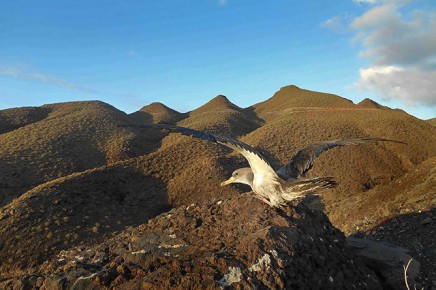
Their scientific name is Calonectris Diomedea.
In Spanish they are called pardela, pardela cenicienta or tapagao. Tail, neck and legs of the „pardelas“ are short and there are webs between their front toes.
Their body length is 45 to 56cm and they weigh 560 to 730g.
Their long, narrow wings feature a span length of 112 - 126cm, which enables them to glide through the air for hours and hours.
Adult birds have a light-grey back. The ventral part is white, except the dark edges of the wings. The tip of their beak is black and bends downwards. It is made out of horn-parts.
The elongated nasal cavities serve to eliminate of the salt content, soaked up with the sea water.
By End of May / Beginning of June Female Birds lay their One and Only Egg on a difficult-to-access Place
Many times this happens near the coast or on the cliffs, rock islands but also further inland in the rock shelters of the Barrancos.
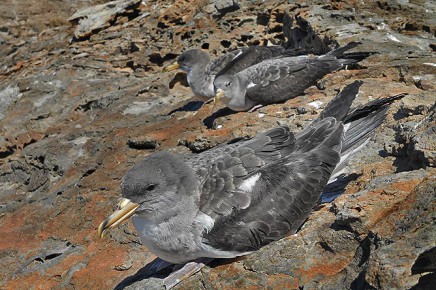
The chick hatches around mid of July, well hidden in a volcanic tube, a rabbit hole or in a rock crevice.
During the day its parents are at the sea hunting for fish, crustaceans and squids.
Later, under cover of nightfall, they return to feed their offspring. This is the time of the bizarre calls resounding through the air.
On La Palma you can watch the Cory Shearwater passing by, for example in the area of Fajana von Barlovento, near Puerto Espíndola and on Playa los Guirres.
For many years, with the aid of thoughtful citizens, many sea birds suffering severe injuries could be rescued.
Although the Cory Shearwater is the exemplary bird of the Canary Islands, its population on the archipelago has alarmingly declined.
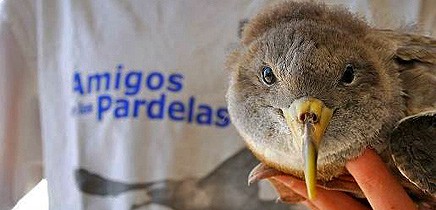
Rats, feral cats and also two-legged poachers are accountable as well as many lights dazzling from surrounding villages and coastal towns.
When birds leave the island by mid of October/beginning of November to migrate to South America, particularly young and unexperienced animals are endangered during their first flight.
The large quantity of lights from towns, villages and streets can make them lose their bearings and fall down dazzled to the ground.
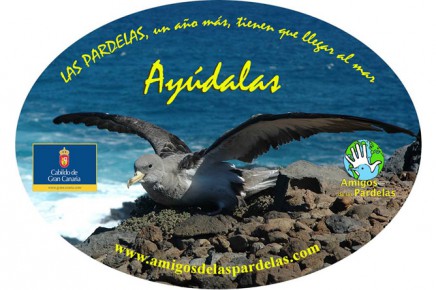 „Pardelas“ sure are excellent divers, but once they hit the ground they are clumsy and have a hard time to take off again.
„Pardelas“ sure are excellent divers, but once they hit the ground they are clumsy and have a hard time to take off again.
That is why they are defenseless towards dog attacks, and towards vehicles overrunning everything as well as when they are abandoned in lonely places at risk of starvation. It is for this reason that volunteer helpers on Gran Canaria founded the "Asociación Amigos de la Pardela cenicienta“.
There is a well established network on the Canary Islands of this voluntary association and from mid of October to end of November friends of the Cory Shearwaters are in action.
Regulations for night sky protection, which applies in La Palma, not only is a pleasure for the staff of the Astrophysical Institute and enthusiasts of astro-turism, also the Cory Shearwater birds benefit from this law and the dark nights on the Isla Bonita.
"Amigos de las Pardelas"
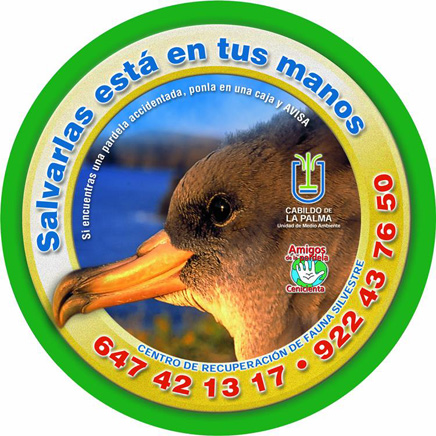
However, in case you pick up any helpless „pardela“ on La Palma, please pack it in a box, put it on a quiet place and call: 922 43 76 50 or 647 42 13 17.
The bird will then be handed over to people with expertise and eventually will receive veterinary attention, in order to be allocated and released and as soon as possible.
For more information (in Spanish) and photos visit:
www.amigosdelaspardelas.com or follow their Facebook site: "Amigos de las Pardelas".
Photos and parts of the texts are a courtesy of the „Asociación Amigos de la Pardela cenicienta“




Die Vögel sind an Land völlig unbeholfen und können kaum laufen, daher sind sie am Boden nicht startfähig.
Von den Steilküsten können sie sich senkrecht runterstürzen und in den Flug wechseln.
Auf dem Wasser starten sie wie ein Wasserflugzeug und die grossen Flossenfüsse - welche am Boden nutzlos sind - helfen ihnen dabei. Sie "laufen" über das Wasser bis sie genug Tempo zum Abheben haben und in den Flug wechseln können.
—
Die Rettung besteht darin:
1. Die Vögel bewusst suchen und/oder auffinden (sie verstecken sich manchmal, wobei sie den Kopf z. B. unter einen Busch stecken und der Rest des Körpers schaut heraus.) Trotzdem sind sie manchmal sehr schwer zu bemerken, da die Oberseite der Vögel grau ist und sie sich ruhig verhalten. Da die Tiere durch ihre kurzen Beine und die große Spannweite ihrer Flügel nicht vom ebenen Boden starten können, bleibt ihnen nichts anderes übrig, als sitzen zu bleiben. Manchmal mitten auf der Straße, auf Treppen, Terrassen, an der Küste.
Die Vögel starten nachts zu ihrem Flug über das Meer in Richtung Brasilien, Argentinien. Meist sind es Jungvögel, die bei ihrem ersten Flug abstürzen. Da sie am Boden hilflos sind, kann man auch tagsüber verunglückte Tiere finden.
Wenn die Vögel sehr jung sind, haben sie teilweise noch keine richtigen Federn, sondern eher einen Haarflaum. Stürzen sie ins Wasser, können sie auch von dort nicht wieder abheben und ertrinken.
2. Wer einen Sturmtaucher auf dem Boden findet, sollte ihn mithilfe einer Jacke/Handtuch o. ae. ergreifen und in eine Kiste mit Luftlöchern setzen.
3. Anschließend die mehrsprachige Notrufnummer 112 anrufen.
Die Tiere werden dann von Fachleuten (Biologen, "Amigos de las Pardelas") abgeholt, untersucht und beobachtet. Haben sie keine Verletzungen, werden sie am nächsten oder übernächsten Tag von einem hohen Platz (Klippe, Aussichtspunkt) fliegen gelassen. Ist ein Vogel verletzt, kommt er in das “Rehabilitationszentrum Fauna Silvestre” in Puntallana. Dort in der Rettungsstation für Wildtiere wird er behandelt und erst, wenn er flugfähig ist in die Freiheit entlassen.
Sind die Vögel abgeflogen, versorgen sie sich selbst. Die Elterntiere haben das Füttern schon Tage vorher eingestellt und sind selbst losgeflogen. Wer mit dem Fernglas auf den Atlantik blickt oder mit dem Boot unterwegs ist, wird zwischen dem 15.10. und 15.11. viele Altvögel entdecken. Ob sie dort auf ihren Nachwuchs warten, weiß ich allerdings nicht.
Ein großer Beitrag zum Schutz der Sturmtaucher ist das Ausschalten starker Lichtquellen, das verhindert, dass die Vögel die Orientierung verlieren und hilft ihnen sicher Richtung Meer zu fliegen.
Es gibt überhaupt keine Information zur Rettung.
Wenn die Jungvögel gefunden werden, was tun die Retter?
Und vor allem:
Wenn die Vögel dann an einer Steilküste freigelassen werden:
Wer füttert diese Vögel dann weiter?
Sie können doch auch nicht vom Wasser starten, oder?
Man könnte vermuten, daß die Vögel dann verhungern.
Bitte geben Sie doch mal konkrete Informationen ab!!!!
Interessant
Was aber tun die Jungvögel, die die Helfer an eine Klippe am Strsnd bringen und die dann fliegen?
Landen diese Vögel bald im Meer?
Können Sie aus dem Wasser starten?
Wie können Sie als Jungvögel fressen?
Oder glaubt man, dass die Elterntiere diese Jungvögel finden??
Bitte antworten auch an Ftm@project-biz.de, keine meiner Mailadressen wurden als gültig angesehen
Toll, dass dieser Vogel geschützt wird.
Herrje, sind gestern auf GC angekommen und just fällt uns am Srtand las Burras so ein Vogel buchstäblich vor die Füße.... Hätten wir diese Information vorher gelesen hätte ich reagieren können
Very interesting. We are visiting La Palma and can hear the strange calls of these birds at night as they pass overhead going to the rocks behind. Fabulous!
Hi,
Ich bin seit langen Jahren immer wieder auf LaPalma und habe mir schließlich hier ein Haus gekauft. Ich freue mich besonders auf die Rufe der Gelbschmanelsturmtaucher am Playa Los Guirres. Dieses Jahr könnte ich sie nicht hören. Sind sie durch das grelle Licht des Kioskos verscheucht worden? Wo gibt es sie noch auf La Palma? Gerne würde ich mich für ihren Schutz engagieren. Und wenn es es mit einer Geldspende ist.
Viele Grüße und ich freue mich auf Ihre Antwort.
Regina Walz
Tolle Berichterstattung, aber ich suchte nach einer Erklärung, warum der Gelbschnabelsturmtaucher nun Sepiasturmtaucher benannt wird. Wie ich lese, taucht der Vogel nach kleinen Fischen! Von Sepia habe ich noch nichts gelesen.
Vielen lieben Dank für diesen Artikel!
Ich höre jetzt nachts die Pardelas überm Haus und freue mich darüber. Kenne sie von La Gomera - Valle Gran Rey. Schön, daß Sie hier so ausführlich drüber berichten.
Franziska Peterthalner, Los Cancajos